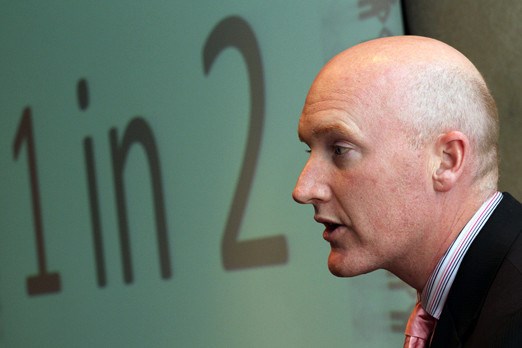Oncologist Dimitrios Vergidis would be happy to work himself out of a job.
As chief of the oncology department at Thunder Bay Regional Health Sciences Centre, Vergidis said the hospital’s new four-year cancer strategy might not accomplish his goal, but he thinks it’s the best-case scenario patients could ask for.
And ask for it they did.
But what’s important is that hospital officials listened, he said.
“This plan will improve what we have in place already,” Vergidis said on Friday, after helping unveil the nine-point strategy that focuses on screening, patient services and $30 million in new equipment that should help with early detection, which in turn will save lives.
“It will increase patients who are screened for cancer. We’re going to be offering a comprehensive screening for cervical, bowel cancer and breast cancer. It will increase the diagnostic approach to cancer, to have it rapidly diagnosed.”
Under the plan, new equipment will include the replacement of a pair of linear accelerators in the radiation department, improved palliative care, improvements to the out-patient experience, better access to support team staff and new electronic health strategies to improve information flow for patients.
Given the numbers they’re dealing with, it’s a must said TBRHSC chief executive officer Andree Robichaud.
There were 5,300 visits to the hospital’s outpatient clinic in 2010 and 1,300 new cases of cancer detected. More than 6,000 Northwestern Ontarians are living with the disease.
“We need to see these numbers go down,” Robichaud said, quick to point out the hospital is already among the top three in Ontario when it comes to wait times and other evaluative measures.
Cancer survivor Dawn Powell, who acted as a patient advisor during the nine-month strategic planning session, said she had excellent care as she went through the system. But there’s always room for improvement.
The four-year plan does a lot to address these concerns, she said.
“There’s a time when you’re sick and not feeling well at three o’clock in the morning, or on a weekend when you can’t access (the centre). Now there’s going to be improved access. There will be a lot of things that can be done electronically. Hopefully there will be a navigator to help people through the system,” she said.
“There will be improved connections between the doctors and the patients, move involvement. And it’s only going to get better.”
Michael Power, regional vice-president of Cancer Care Ontario and a high-ranking hospital official, said it wasn’t easy narrowing the plan to nine key strategies, but it was a necessary process to ensure the facility moves in the best direction.
What’s great about the nine, he said, is they represent all aspects of the cancer-care continuum.
“So it’s not a plan to improve cancer treatment at the expense of screening or the expense of palliation. But rather it has an emphasis on prevention and screening all the way through treatment, palliation and supportive care,” Power said.
Sign in or register
- Messages
- Post a Listing
- Your Listings
- Your Profile
- Your Subscriptions
- Your Likes
- Your Business
- Support Local News
- Payment History
Registered Users
Already have an account?
New Users
Create a free account.
